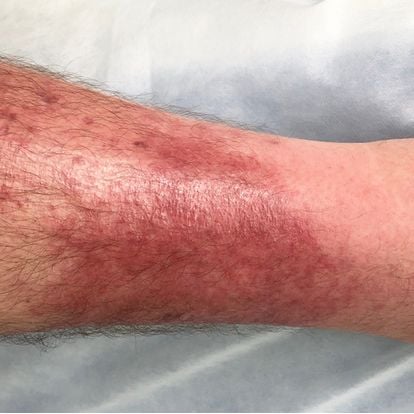 OVERVIEW
OVERVIEW
The skin is the body's first line of immunity, also referred to as the innate immune system. Therefore, it is not surprising that it is also the first place where bacteria enter our bodies.
Most infections occur when bacteria or germs find their way into the skin; this happens in the case of erysipelas, an infection of the upper layers of the skin. The condition can cause a red, tender area on the skin that may become swollen and painful.
The burden of Erysipelas in the United States is estimated at 14.5 million cases annually, with over 650,000 hospital admissions.
Signs and Symptoms: What are the Clinical Features of Erysipelas?
Erysipelas typically appears as a red, swollen, tender lesion that can be very painful and cause. Erysipelas may also cause other symptoms, including:
- Fever
- Chills
- Shivering
- Tiredness/Fatigue
- Headaches
- Nausea/Vomiting
Cause: What Causes Erysipelas?
Erysipelas is a skin infection caused by bacteria, particularly Streptococci specie. Group A streptococci are responsible for erysipelas of the face. Non-group A streptococci affect other parts of the body. While Streptococcus specie is the major culprit for this infection, different organisms have also been reported to cause erysipelas, although with rarity. They include:
- Staphylococcus aureus
- Klebsiella pneumoniae
- Haemophilus influenzae
- Escherichia coli
- Staphylococcus warneri
- Moraxella species
Diagnosis: How is Erysipelas Diagnosed?
To diagnose erysipelas, your doctor will take a medical history and perform a physical examination. A physical exam will check for features such as red, swollen, tender lesions with distinct margins.
If your doctor suspects erysipelas, they will order a blood test and culture
.A positive blood test will show increased
- Increased C-reactive protein (CRP) level.
- Neutrophilia (increased number of neutrophils, a type of white blood cell)
Risk Factors: What are the Risk Factors of Erysipelas
There are a variety of risk factors that can increase your chances of getting erysipelas, including:
- Age: Infants, young children, and the elderly are more prone to this infection.
- Skin Sores
- Cuts
- Diabetes mellitus
- Pregnancy
- Obesity
- Alcoholism
- Prior injuries
- History of erysipelas
- Surgical wounds
- Radiotherapy
Treatment: Treatment of Erysipelas
Treatment of erysipelas depends on their severity. Treating it early with antimicrobial drugs such as antibiotics can help prevent complications and reduce the risk of recurrence. The therapy is administered orally (by mouth) or intravenously (by vein). Antibiotics of choice include:
- Oral Penicillin
- Erythromycin (an oral alternative for people allergic to penicillin)
- Penicillin G intravenous for severe cases
- Ceftriaxone or Cefazolin alternative intravenous for people allergic to penicillin
- Oral Dicloxacillin when Methicillin sensitive Staphylococcus aureus is present
Complications: What Are the Complications of Erysipelas?
Early treatment of erysipelas can help prevent complications and reduce the risk of recurrence. Complications of erysipelas are rarely fatal but can be serious. They include:
- Abscess formation
- Pneumonia
- Scarlet fever
- Meningitis
- Skin necrosis
- Hemorrhagic purpura
- Thrombophlebitis
- Bullous formation.
Preventative measures: Can You Prevent Erysipelas?
You can do a few things to prevent this infection from occurring: keep your immune system healthy by eating a balanced diet and getting enough exercise. Other preventative measures include:
- Keep your skin clean and dry
- Avoid cuts and scratches
- Sanitize any wounds or scratches
- Avoid contact with infected skin
- Drink plenty of fluids
- Get plenty of rest
- Seek medical attention if you develop symptoms
- Take antibiotics if prescribed
- Seek medical attention if your condition worsens
Although the skin plays a key role in protecting us from diseases, it is not immune to infection. Like many other skin infections, erysipelas has a devastating effect on aesthetics. The best way to prevent this infection is to keep your immune system strong and healthy. It is also beneficial to contact a doctor if you develop symptoms of erysipelas.

 OVERVIEW
OVERVIEW
